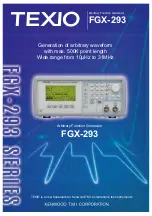
Components Replacement Guidelines
Maintenance Procedures
Force 2 Service Manual
6
-
15
Components Replacement Guidelines
Follow these guidelines when installing and mounting components on
circuit boards.
1.
Install all nonpolarized components so that the value, tolerance, and
part number are visible.
2.
Install polarized components correctly so that the positive symbol (+),
negative symbol (-), or other polarization markings are visible.
3.
Do not remove coatings beyond the point where the lead enters the
component body. For example, use a soldering iron to remove coating
on the leads.
4.
Center the component body between bends (except for miniature
diodes, where it is desirable to leave the cathode lead longer than the
anode lead for identification). Line up the leads, where required, with
the mounting holes prior to installation.
5.
Position lead-mounted components so that the major axis of the
component is parallel to any two of the three major planes (sides) of
the unit. Mechanically support any component having a weight in
excess of 14.18 g (1/2 oz.) by means other than the leads.
6.
Properly insulate all component leads which are, or could be, forced
into a shorting condition with another component lead or circuit.
7.
Do not stress component leads between mounting pins. Provide an
adequate strain relief to prevent damage to the component and solder
pins.
8.
When installing components on circuit boards with the circuitry on the
component side of the board, insulate the metallic bodies of the
components with sleeving.
9.
Mount resistors rated at 2 W or less flush to the circuit board
(0.0–0.15 cm [0.0 - 0.06 in.] clearance).
10.
Mount resistors greater than 2 W 0.635 cm ± 0.15 cm (0.25 in. ± 0.06 in.)
from the surface of the board.
11.
Radial lead capacitors: if installation requires bending the lead, the
bend should be no closer to the body than 0.15 cm (0.06 in.) Mounting
height should be 0.08–0.64 cm (0.032–0.25 in.) from the board surface to
the potting material.
12.
Soldered surfaces should be clean and free of contaminants that would
result in poor soldering.
13.
Control soldering temperature to prevent damage to components or
circuitry.
14.
Use no clean wire solder for general soldering on circuit boards.
Содержание Force 2-2 PCH
Страница 1: ...Service Manual Force 2 Electrosurgical Generator...
Страница 10: ...Notes x Force 2 Service Manual...
Страница 16: ...Notes 2 4 Force 2 Service Manual...
Страница 32: ...Notes 4 10 Force 2 Service Manual...
Страница 52: ...Typical Output Waveforms 6 12 Force 2 Service Manual Figure 6 5 Coag 300 Load...
Страница 56: ...Notes 6 16 Force 2 Service Manual...
















































